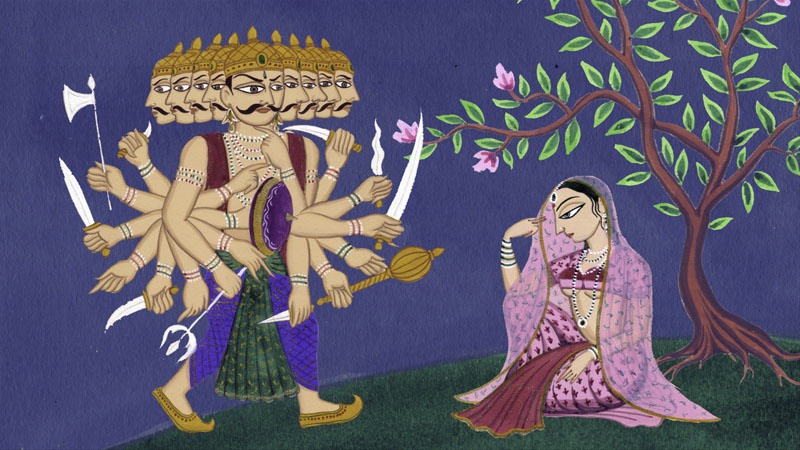Ravana confronts Sita. Still from Sita Sings the Blues (2009).
Source: Wordpress
The intermingled visual and storytelling styles of this film mirrors the variety of styles in which the Ramayana has been told. One of the first section is a colorful, almost psychedelic presentation of the cosmos. Three celestial beings are shown introducing the story of the Ramayana and discussing it as would a group of friends. They offer a commentary throughout the film and provide it with a surprisingly modern commentary, such as on the idea of “purity” in women. They provide humor to a story that, in almost every aspect, lacks it. Among other things, they discuss the vehicle by which Rama and Sita returned to the kingdom and compare it to airplanes.
Laced throughout the story of the Ramayana are sections devoted to the story of a couple who are separated for some time when the man (Dave) is sent to India as part of a business contract. The story of this couple is divided in such a way that its depiction of separation and reunion come around the same time that Rama and Sita are separated and reunited. The title refers to various musical sections in the film in which “Sita” sings early jazz or swing love songs whose lyrics reflect the story of Rama and Sita.
Given that the Ramayana is an ancient story, it seems inevitable that it should be told over the years in a variety of styles and in a variety of cultures. While the story of this couple doesn’t necessarily capture the same level of desperation that a kidnapping would cause, it does display one of the themes of the Ramayana in a way that’s likely more relatable to modern audiences. Few of us will have to rescue a loved one from a demon king.
That layer of modern commentary is the most interesting aspect of this film to me. Through this, the film becomes much more than an animated adaptation of the Ramayana.
Paley, Nina. Sita Sings the Blues, 2009. Link.
Bibliography
Paley, Nina. Sita Sings the Blues, 2009. Link.

No comments:
Post a Comment